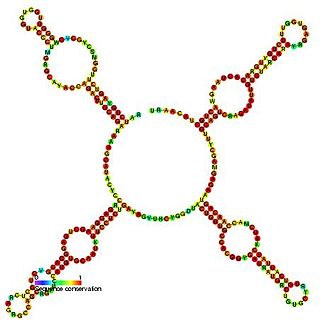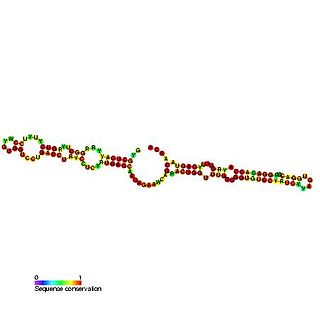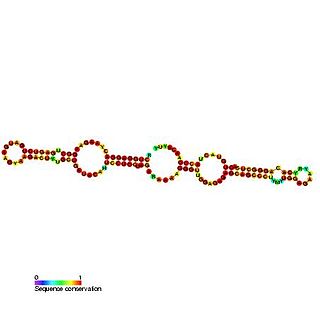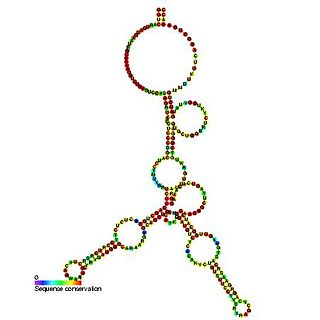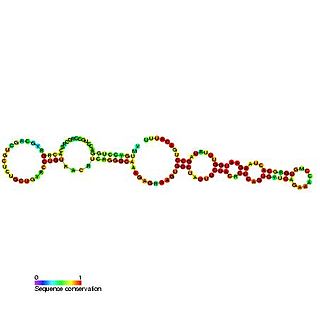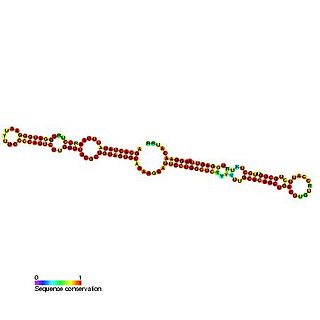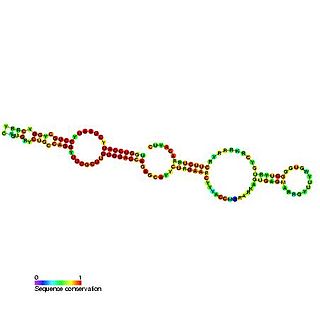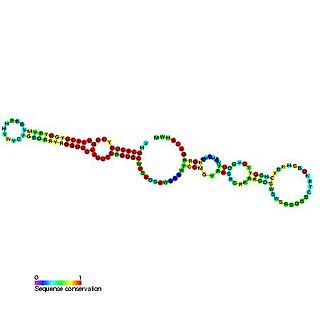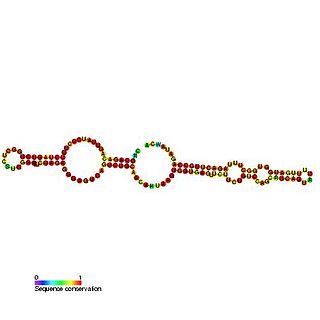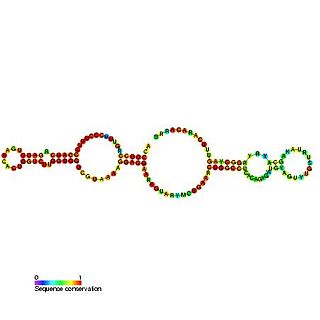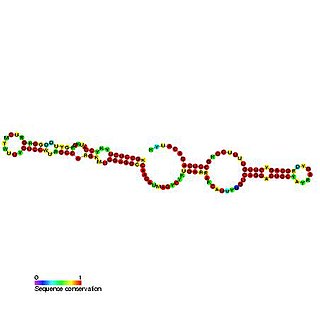| Small Cajal body specific RNA 11 | |
|---|---|
Predicted secondary structure and sequence conservation of SCARNA11 | |
| Identifiers | |
| Symbol | SCARNA11 |
| Alt. Symbols | snoACA57 |
| Rfam | RF00564 |
| Other data | |
| RNA type | Gene; snRNA; snoRNA; scaRNA |
| Domain(s) | Eukaryota |
| GO | 0006396 0015030 0005730 |
| SO | 0000275 |
In molecular biology, Small Cajal body specific RNA 11 (also known as scaRNA11 or ACA57) is a small nucleolar RNA found in Cajal bodies.

Molecular biology is a branch of biology that concerns the molecular basis of biological activity between biomolecules in the various systems of a cell, including the interactions between DNA, RNA, proteins and their biosynthesis, as well as the regulation of these interactions. Writing in Nature in 1961, William Astbury described molecular biology as:
...not so much a technique as an approach, an approach from the viewpoint of the so-called basic sciences with the leading idea of searching below the large-scale manifestations of classical biology for the corresponding molecular plan. It is concerned particularly with the forms of biological molecules and [...] is predominantly three-dimensional and structural – which does not mean, however, that it is merely a refinement of morphology. It must at the same time inquire into genesis and function.
Small nucleolar RNAs (snoRNAs) are a class of small RNA molecules that primarily guide chemical modifications of other RNAs, mainly ribosomal RNAs, transfer RNAs and small nuclear RNAs. There are two main classes of snoRNA, the C/D box snoRNAs, which are associated with methylation, and the H/ACA box snoRNAs, which are associated with pseudouridylation. SnoRNAs are commonly referred to as guide RNAs but should not be confused with the guide RNAs that direct RNA editing in trypanosomes.

Cajal bodies (CBs) also coiled bodies, are spherical sub-organelles of 0.3–1.0 µm in diameter found in the nucleus of proliferative cells like embryonic cells and tumor cells, or metabolically active cells like neurons. In contrast to cytoplasmic organelles, CBs lack any phospholipid membrane which would separate their content, largely consisting of proteins and RNA, from the surrounding nucleoplasm. They were first reported by Santiago Ramón y Cajal in 1903, who called them nucleolar accessory bodies due to their association with the nucleoli in neuronal cells. They were rediscovered with the use of the electron microscope (EM) and named coiled bodies, according to their appearance as coiled threads on EM images, and later renamed after their discoverer. Research on CBs was accelerated after discovery and cloning of the marker protein p80/Coilin. CBs have been implicated in RNA-related metabolic processes such as the biogenesis, maturation and recycling of snRNPs, histone mRNA processing and telomere maintenance. CBs assemble RNA which is used by telomerase to add nucleotides to the ends of telomeres.
scaRNAs are a specific class of small nuclear RNAs which localise to the Cajal bodies and guide the modification of RNA polymerase II transcribed spliceosomal RNAs U1, U2, U4, U5 and U12. [1] [2] ACA57 belongs to the H/ACA box class of guide RNAs as it has the predicted hairpin-hinge-hairpin-tail structure, conserved H/ACA-box motifs and is found associated with GAR1. [1] ACA57 is predicted to guide the pseudouridylation of the U5 spliceosomal RNA at position U43. [3]
Small nuclear ribonucleic acid (snRNA) is a class of small RNA molecules that are found within the splicing speckles and Cajal bodies of the cell nucleus in eukaryotic cells. The length of an average snRNA is approximately 150 nucleotides. They are transcribed by either RNA polymerase II or RNA polymerase III. Their primary function is in the processing of pre-messenger RNA (hnRNA) in the nucleus. They have also been shown to aid in the regulation of transcription factors or RNA polymerase II, and maintaining the telomeres.

RNA polymerase, both abbreviated RNAP or RNApol, official name DNA-directed RNA polymerase, is a member of a family of enzymes that are essential to life: they are found in all living organisms and many viruses. RNAP locally opens the double-stranded DNA so that one strand of the exposed nucleotides can be used as a template for the synthesis of RNA, a process called transcription. A transcription factor and its associated transcription mediator complex must be attached to a DNA binding site called a promoter region before RNAP can initiate the DNA unwinding at that position. RNAP has intrinsic helicase activity, therefore no separate enzyme is needed to unwind the DNA. RNAP not only initiates RNA transcription, it also guides the nucleotides into position, facilitates attachment and elongation, has intrinsic proofreading and replacement capabilities, and termination recognition capability. In eukaryotes, RNAP can build chains as long as 2.4 million nucleotides.

A spliceosome is a large and complex molecular machine found primarily within the nucleus of eukaryotic cells. The spliceosome is assembled from snRNAs and approximately 80 proteins. The spliceosome removes introns from a transcribed pre-mRNA, a type of primary transcript. This process is generally referred to as splicing. An analogy is a film editor, who selectively cuts out irrelevant or incorrect material from the initial film and sends the cleaned-up version to the director for the final cut.

